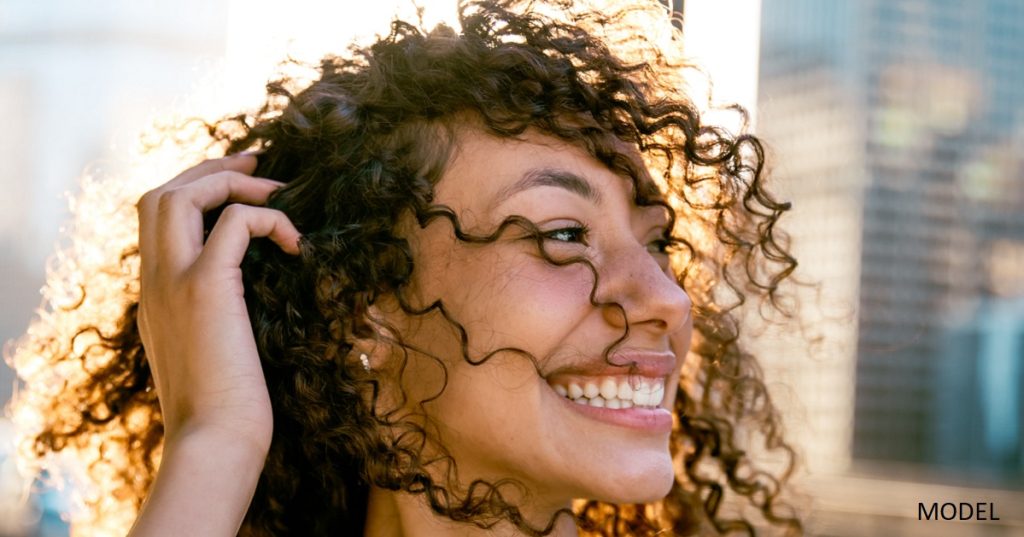1. What is IPL?
Intense Pulsed Light therapy (IPL) is a light based therapy that involves exposing the skin to a narrow range of wavelengths of light in order to target areas of pigment and skin irregularity. The irregular, aged and pigmented skin absorbs this light, and cells in these areas are therefore subjected to targeted heat, resulting in the damaged cells sloughing off, causing the irregularity to fade away.
2. Can IPL Really Make Your Skin Look Younger?
Yes! Because IPL targets multiple skin concerns, many of which increasingly appear as we age, IPL does result in younger looking skin, and patients will often note a “ glow” from IPL. Scientific studies in which patients complexions were evaluated by medical personnel prior to IPL and after several treatments, have shown improvement on objective scores of skin age including evaluation of fine lines, tone and texture. While a single treatment with IPL can improve skin appearance with long lasting results, studies show that having 1-3 IPL treatments per year can help maintain more youthful looking skin. IPL is now thought to slow, and potentially reverse signs of skin aging!
3. What Skin Problems Can IPL Improve?
Photofacials primarily target photoaging that has caused red, brown or splotchy, uneven areas of complexion. Skin is smoother and has better tone and texture after IPL. Specific conditions that can be improved by IPL include:
- Discolored skin
- Fine lines
- Broken blood vessels
- Liver or age spots
- Stretch marks
- Red or discolored scars
- Melasma
- Some birth marks
- Fine lines and wrinkles, including peri-oral lines ( “smokers” lines)
- Redness and Rosacea
- Acne and acne scars
- Spider veins
- Freckles
4. How Effective is IPL?
For broken blood vessels studies show patients get 50-75% improvement in broken blood vessels after one treatment.
For redness associated with flushing in Rosacea, IPL may be more effective that laser and other treatments in many patients. Specifically, patients under 40 years of age, and those with moderate to severe flushing do better with IPL.
For brown spots from photoaging, patients can expect improvements of around 70%.
For acne and acne scarring, patients can also obtain significant improvements, but it often takes several treatments.
5. Why Choose IPL Over Other Facial Treatments, Such As Microdermabrasion, Microneedling, or Ultherapy?
There are many effective facial treatments available that ideally can compliment each other, and act synergistically to improve our appearance, so its often not a case of either/or, but rather of combination therapy to achieve best results. IPL differs from treatments like microdermabrasion because it targets deeper layers of the skin, allowing it to specifically address concerns around pigment and blood vessels, because it reaches those areas where broken vessels and stubborn pigment “lives,” so to speak. It can also quell and quiet inflammation, as in conditions like acne, and can therefore be used in irritated and inflamed skin where microneedling would be avoided. Ultherapy also acts on deep tissues, often those beneath the actual skin, targeting the connective tissue that supports the skin, and thus its good for skin tightening.
Microneedling is good for stimulating collagen deposition, and is great for improving pore size and more superficial pigment and lines, and is an excellent way to introduce other healing and antiaging compounds into the skin, as when combined with mesotherapy.
Microdermabrasion is a great “ refresh” to deeply cleanse and brighten the complexion, ideal for a short-term “pick-me-up” at changes in season. Thus, each of these treatments can play a unique role in your skincare regimen.
6. What Areas of the Body Can IPL Treat?
IPL is usually done on the face, chest, hands and arms, though almost any area can be treated.
7. Who Shouldn’t Get IPL?
Patients with very dark skin are not candidates for IPL. Those who are sun tanned or have been using retinol or Retina A in the last two weeks should postpone IPL.
8. Is IPL Painful?
IPL feels a bit like a rubber band being snapped against the skin. It is minorly uncomfortable, and most patients tolerate it without any numbing agent. If you are especially sensitive, ask our aesthetician about the option of applying numbing cream to the skin prior to treatment.
9. Are There Side Effects Caused By IPL?
Patients can expect some redness or darkening of brown spots immediately after treatment. Within a few days brown spots may crust before sloughing or peeling off. IPL done by inexperienced technicians could cause burns, so it is important to have IPL carried about by experienced and well trained medical personnel.
10. Is There Downtime After an IPL Treatment?
While there can be some redness or slight swelling immediately after treatment , it usually dissipates quickly, so for most patients there is no downtime. The darkened or flaking spots that can become apparent within a day to a few days later can usually be covered by make up. It is recommended to have treatment at east a couple of weeks prior to a major event like a wedding.
If you are interested in more information or would like to book an IPL treatment, contact us online or call (905) 273-3045 to book your IPL consultation.


Leave a Reply